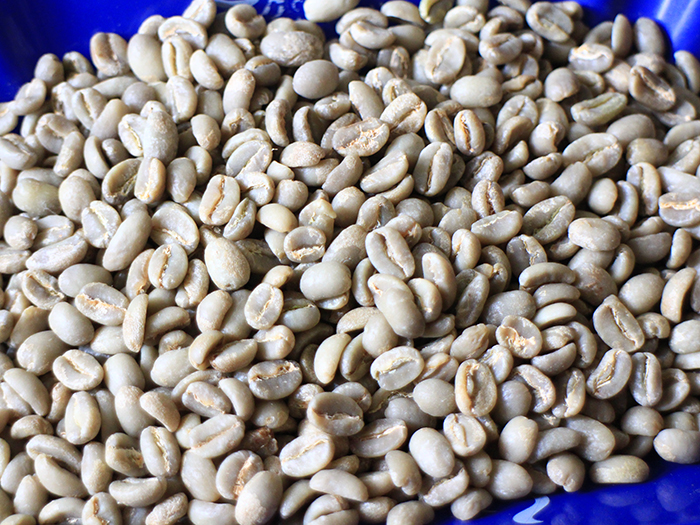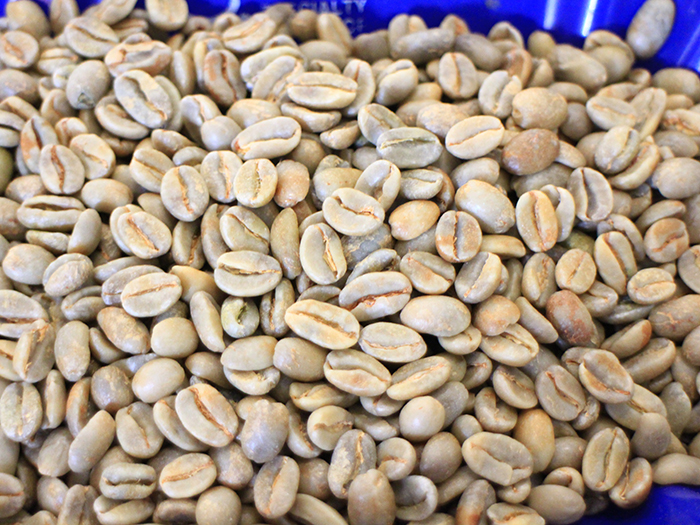How to choose coffee and raw beans by hand? Choose the right raw coffee beans? Rwanda Coffee Mushoi washed raw beans
What kind of raw beans are high-quality raw beans? First look at the surface of the beans, fresh high-quality raw beans, shiny surface, in addition, processed good raw beans, uniform color, uneven color surface can not be called good beans, must choose uniform color when purchasing. Secondly, the particle size is consistent, which is also evidence of good quality management. Make sure the particle size is consistent when purchasing. Uniform and neat coffee beans can achieve consistent roasting effect; otherwise, some are too deep and bitter, and some are too shallow and sour, which will affect the overall taste of roasted coffee beans. Green beans are divided into several grades according to quality standards, which vary from place to place and are basically determined according to size and shape. The higher the grade, the better the quality. At present, because the domestic coffee green bean market has just started, the coffee green beans sold are mainly low-grade futures beans. The green beans we get usually have many flaws. Defective coffee beans are quite harmful, including variants that are not flat beans or round beans, and because of developmental abnormalities, the center of the green beans is broken during shelling. The beans tend to be uneven when baked. Fermented beans/black beans are fermented internally during processing or washing. Fermented sour. Green beans/white dead beans Coffee cherries are harvested before they are fully ripe. The beans are ivory in color and green in taste when baked. Mildew beans processing, transportation process damp, rain, mold breeding. As long as there is a bean mold, it will soon spread to others, be sure to pay attention. Worm-eaten beans are eaten by a pest called coffee beetles, which have wormholes in the beans and give coffee a bad smell.
Country: Rwanda
Production area: Lutexi Luo production area in Western Province
Altitude: 1827 m
Rainfall: >1500mm
Treatment method: washing, elevated shelf drying
Breed: BM-139 (bourbon) species
Treatment Plant: Mousioui Treatment Plant
Farm owners: 1756 smallholder members (approximately 253 plants per smallholder)
Flavor: Red apple, cherry, cinnamon, honey
[Mushonyi Processing Plant's record of winning awards is amazing. Apart from winning the COE Excellence Cup in one fell swoop in 2010, Mushonyi Processing Plant won the championship in four batches in 2011 alone, ranking 12th, 16th, and 28th!!!]
Rwanda can be said to be one of the fast-growing fine coffee producing countries in East Africa. In addition to the sad stories about the Rwandan massacre, the quality of its fine coffee has also improved very quickly. We have tested several fresh, elegant and sour cups this year.
Rwandan coffee, like many African countries, is mainly produced by small farmers. During the harvest period, the ripe coffee cherries are collected and sent to the processing station for processing. Every year, farmers gather ripe coffee berries for processing at processing stations, first picking them by hand to ensure that no immature or damaged fruit is mixed in. Then remove the peel, wash and ferment for 12-18 hours under cool and low temperature environment, and clean the adhered pectin in the channel. During the drying process, the members of the processing station will manually turn and carefully care to ensure that the shelled green beans do not lose moisture or dry unevenly in full sunlight until the moisture content stability of the green beans drops to less than 14%.
We have also introduced several collections from Nyamasheke in Rwanda, this time carefully selected Mushonyi from Rutsiro, north of Nyamasheke, also on Lake Kiev. High altitude, fertile volcanic soil, and excellent climate make good coffee. We will continue to cultivate this gemstone producing area in Luanda, this batch is a direct trade batch purchased from the processing plant, the latest fresh batch harvested in the 2015 season (about June to September)!
This batch of flavor short review:
Red apples, cherries, cinnamon and honey, excellent sweetness and balance, cinnamon, almonds, chocolate finish

Important Notice :
前街咖啡 FrontStreet Coffee has moved to new addredd:
FrontStreet Coffee Address: 315,Donghua East Road,GuangZhou
Tel:020 38364473
- Prev

How to choose coffee and raw beans by hand? Choose the right raw coffee beans? Panamanian water washed rose summer beans
What kind of raw beans are high-quality raw beans? First look at the surface of beans, fresh and high-quality raw beans, the surface is shiny, in addition, the processing of good raw beans, uniform color, the surface of uneven color can not be called good beans, must choose uniform color. Secondly, the particle size is the same, which is also evidence of good quality management. Make sure that the particle size is the same when you buy it.
- Next

How to choose coffee and raw beans by hand? Choose the right raw coffee beans? 90 + sun-dried raw beans imported from Sidamo
What kind of raw beans are high-quality raw beans? First look at the surface of beans, fresh and high-quality raw beans, the surface is shiny, in addition, the processing of good raw beans, uniform color, the surface of uneven color can not be called good beans, must choose uniform color. Secondly, the particle size is the same, which is also evidence of good quality management. Make sure that the particle size is the same when you buy it.
Related
- Detailed explanation of Jadeite planting Land in Panamanian Jadeite Manor introduction to the grading system of Jadeite competitive bidding, Red bid, Green bid and Rose Summer
- Story of Coffee planting in Brenka region of Costa Rica Stonehenge Manor anaerobic heavy honey treatment of flavor mouth
- What's on the barrel of Blue Mountain Coffee beans?
- Can American coffee also pull flowers? How to use hot American style to pull out a good-looking pattern?
- Can you make a cold extract with coffee beans? What is the right proportion for cold-extracted coffee formula?
- Indonesian PWN Gold Mandrine Coffee Origin Features Flavor How to Chong? Mandolin coffee is American.
- A brief introduction to the flavor characteristics of Brazilian yellow bourbon coffee beans
- What is the effect of different water quality on the flavor of cold-extracted coffee? What kind of water is best for brewing coffee?
- Why do you think of Rose Summer whenever you mention Panamanian coffee?
- Introduction to the characteristics of authentic blue mountain coffee bean producing areas? What is the CIB Coffee Authority in Jamaica?

